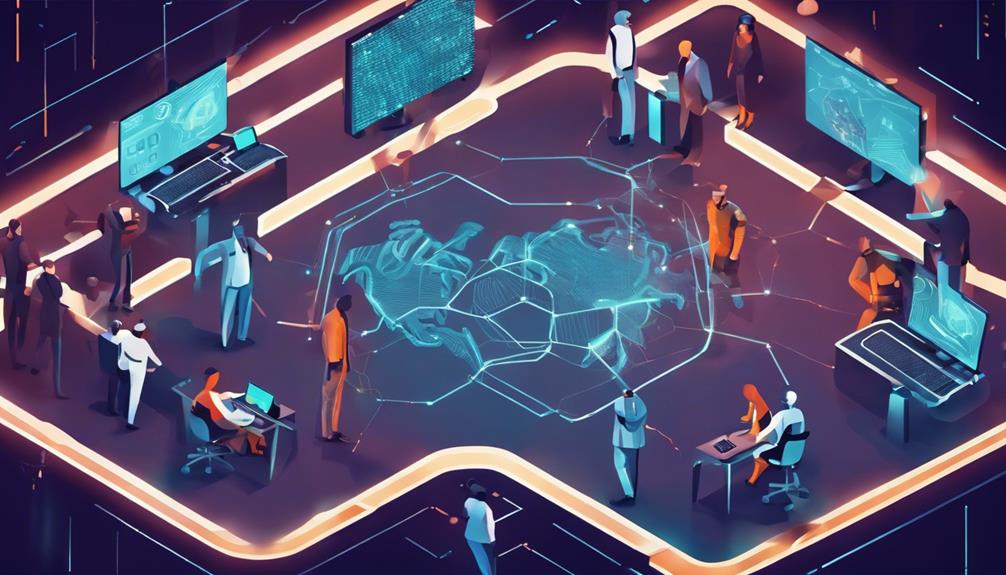Artificial intelligence has transformed cybersecurity, introducing a wave of sophisticated threats. To safeguard against these evolving risks, organizations must adopt advanced defense strategies. AI technologies enable attackers to automate attacks, emphasizing the importance of robust security protocols. Deepfakes further complicate security, requiring vigilance and specialized tools for detection. Proactive monitoring and early response plans are essential in combating disinformation campaigns. Defending against AI-powered threats demands implementing AI-driven security tools and enhancing real-time visibility. Prioritizing cyber resilience, encryption software, and multifaceted defense approaches is vital in maneuvering the complex cybersecurity landscape. Enhancing awareness of these threats is important for fortifying digital defenses.
Key Takeaways
- AI advancements lead to sophisticated cyber threats.
- Organizations must implement AI-powered detection tools.
- AI technologies automate attacks and exploit vulnerabilities.
- Robust security protocols are crucial in the evolving threat landscape.
- Understanding AI-powered threats and implementing multifaceted defense strategies is essential.
AI Cyber Threats Overview
Numerous advancements in artificial intelligence have led to an increase in sophisticated cyber threats, including prompt hacking, deepfake scams, and zero-day exploits, posing significant risks to organizations worldwide. The integration of AI and machine learning models has revolutionized the cybersecurity landscape, with attackers leveraging these technologies to automate attacks, exploit vulnerabilities, and enhance intrusion capabilities. Businesses are facing a rapidly evolving threat landscape where traditional security measures may no longer suffice.
To combat these AI-driven threats effectively, organizations must prioritize implementing robust security protocols, enhancing threat detection mechanisms, and fostering a culture of Vulnerability Disclosure.
By staying informed about emerging threats and investing in AI-powered detection tools, companies can proactively identify and mitigate potential risks. Additionally, establishing thorough guardrails to prevent AI misuse is essential in safeguarding against large-scale automated attacks and minimizing the impact of malicious activities enabled by AI systems.
In this dynamic cybersecurity environment, understanding the intricacies of AI cyber threats is essential for protecting sensitive data and maintaining operational resilience.
Deepfake Impact on Security

In addition, deepfakes are leveraged in influence campaigns, amplifying societal tensions and disseminating false narratives. These manipulated videos and audios pose risks of spreading misinformation and perpetrating fraud, making it increasingly difficult to discern truth from deception.
Deepfakes, generated through sophisticated AI technology, have become a significant security threat by blurring the lines between reality and manipulation.
Deepfakes created using AI technology heighten the risk of misinformation and fraud.
Deepfakes are utilized in influence campaigns to sway opinions and spread false narratives.
Detecting and combating deepfakes require advanced tools and strategies to counter the dissemination of manipulated content effectively.
Developing robust detection tools and response strategies is essential to safeguard security and trust in an environment where deepfake attacks are prevalent.
Strategies for Detecting Disinformation

Effective strategies for detecting disinformation in today's digital landscape require a proactive approach utilizing advanced technology and vigilant monitoring.
With the rise of AI-powered disinformation, early detection tools and scenario plans play an essential role in combating false narratives propagated through deepfakes and information manipulation.
These tools can help organizations identify and respond swiftly to cyber incidents involving disinformation campaigns aimed at creating social unrest and influencing public opinion, particularly during sensitive events like elections.
Defending Against AI-Powered Threats

In light of the escalating concern surrounding AI-powered threats in cybersecurity, safeguarding against these evolving risks has become imperative for organizations seeking to fortify their defense mechanisms. As the cybersecurity landscape continues to evolve, defending against AI-powered threats requires a multifaceted approach that addresses both external and internal risks.
Here are key strategies to enhance protection:
- Implement Advanced Threat Detection: Utilize AI-driven cybersecurity tools to enhance threat detection capabilities and identify potential security threats in real-time.
- Address Internal Risks: Mitigate the risks associated with shadow AI by educating employees about the dangers of using generative AI systems and implementing strict cybersecurity measures.
- Enhance Real-time Visibility: Leverage AI technologies to gain real-time visibility across digital assets, enabling proactive responses to security incidents and ensuring a robust defense against AI-powered threats.
Navigating Evolving Cybersecurity Risks

Amid the dynamic landscape of cybersecurity threats, organizations face the ongoing challenge of managing evolving risks posed by advanced technologies and sophisticated adversaries. With the rapid increase in AI applications, deepfake scams, and zero-day exploits, businesses must prioritize cyber resilience and network security to safeguard their digital assets.
Implementing robust encryption software is vital in fortifying defenses against AI-driven attacks and deepfake scams, ensuring data protection in the face of evolving cyber threats.
To navigate these risks effectively, organizations should leverage threat intelligence and AI tools to stay informed about the latest security trends. AI systems play a pivotal role in detecting zero-day exploits and automating threat identification, enabling proactive defense measures against emerging threats.
Frequently Asked Questions
What Is the Current Cybersecurity Threat Landscape?
The current cybersecurity threat landscape is characterized by evolving risks, including sophisticated malware, internal threats like shadow AI, and ransomware-as-a-service platforms like Medusa. Attackers increasingly leverage AI for deepfake scams, posing significant challenges for organizations.
What Are the Cybersecurity Risks Associated With Artificial Intelligence?
What are the cybersecurity risks associated with artificial intelligence? As AI evolves, so do the threats. Risks include prompt hacking with AI tools, deepfake scams, surge in zero-day exploits, and network intrusions. Vigilance and advanced security measures are essential.
What Is Cyber Risk Landscape?
The cyber risk landscape refers to the overall scope of potential threats and vulnerabilities that organizations face in the digital environment. It encompasses risks like data breaches, ransomware attacks, and phishing scams, necessitating proactive cybersecurity measures for protection.
Does AI Collect Personal Data?
AI systems can collect personal data through diverse channels such as user interactions and IoT devices. Understanding how AI systems gather and process personal data is essential for protecting privacy and data security.
Conclusion
To sum up, grasping the new threat landscape of AI cybersecurity is essential in today's digital world.
By acknowledging the potential impact of deepfake technology and implementing effective detection strategies, organizations can better defend against AI-powered threats.
Maneuvering through the evolving risks requires vigilance and adaptability.
Stay informed, stay proactive, and stay secure in the face of these ever-changing cybersecurity challenges.









